As photographers, we are always looking for ways to stretch our creative limits. We want to create the most amazing photos possible, but sometimes we lack the motivation. In her lecture “From Static to Dynamic: Creating Photographs with Impact,” This video teaches us how to tap into our creativity, develop a creative vision, and implement a variety of tools and techniques to test drive on the next shoot:
Can You Learn to Be Creative?
Tharp says this is one of the most common questions asked in her workshops, and her answer is this:
“You can develop creative vision. You can develop your own unique creativity. But, you really have to open yourself up to things. You have to develop that creativity by opening your eyes to see the world around you more deeply.”
How to Develop Your Creativity
Brenda Tharp best describes this technique as “practicing daily seeing,” meaning you should always have your eyes open and be present in the moment. Here are a few of Tharp’s suggestions to help develop your creativity:
- Practice “daily seeing” without your camera. When you’re out and about, pay attention to your surroundings and make mental notes of places or situations that would make a great picture.
- Focus on your composition. Regardless of the subject, contemplate the placement of the subject in your photograph. Consider the message you are trying to convey, and (as always) make use of the rule of thirds.
- Look at the light. Many photographers agree the best natural light occurs just after sunrise and about an hour before sunset. While this does provide you with the nice, warm, diffused light, you should also pay attention to the way the high sun affects shadows, colors and details on your subject. This will help you know what to do to alter the natural light if you do schedule a mid-day shoot.
- Believe you are creative. Even if you master the use of natural lighting and composition, you need to maintain the core belief that you are creative. If you lack this belief, you may struggle with making your best pictures.
- Fight self doubt. Every photographer is affected by self doubt. When you see an amazing photograph, you may question whether or not you would be able to create the same image. Rather than listen to your inner critic, you should allow yourself to play creatively and snap photos outside your comfort zone. You will probably be pleasantly surprised by the results.
- Look beyond the simple subject and find the “hidden gem” of the picture.

“The color palate of the rose was so yummy, but I knew there was something more to it than just the picture of the rose,” says Tharp. She looked deeper into the flower and saw the layers of the petals with this single dew drop.
- Be aware of your surroundings and learn to “sift through the chaos.” Tharp suggests that by looking deeply into what you’re seeing, you can take a nice (but chaotic) photo and turn it into something else.
How to Photograph Fleeting Moments
You should have your camera ready to capture these potentially fleeting moments. To practice this style of photography, give these tips a try:
- Be on the lookout. While you’re out running errands or taking a walk, bring your camera along. Snap a photo if something strikes your fancy.
- Pay attention to the fringes of activity. If you are shooting at an event, most people will be focused on the main performance. You can often get some interesting and insightful photos by snapping pictures of people watching the action, or smaller activities taking place “in the fringe.”
- Respond to something specific. Create a little checklist of things to guide your eye when you’re out shooting. For example, you may want to focus on color, shadow, texture, humor, size, perspective, reflection, or lighting.

Pay attention to color and shadows.
Imagination Is More Important Than Knowledge
Tharp suggests asking “what if…” questions to capture a more unusual photograph. Consider panning your camera horizontally while snapping a shot of a sunset with a slow shutter to get a velvety, painted look, or use a slow shutter with a vertical pan in a forest to create an abstract, blended shot of the trees. She says it is still important to pay attention to the composition of the photo and aim to create depth when making an abstract.
This abstract style can give a more “art-like” appearance to an otherwise straightforward shot.
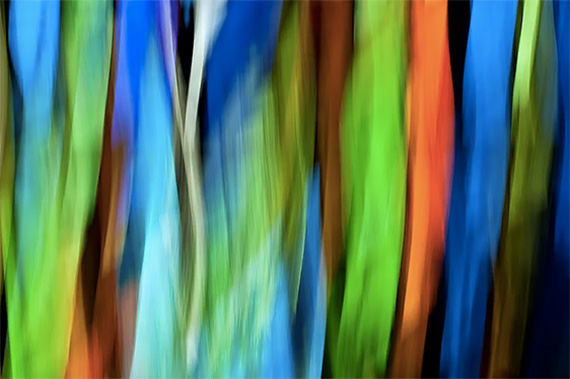
Tharp visited a church that had amazing stained glass windows. She didn’t want to capture the religious message portrayed in the windows, but really loved the colors. Combining the slow shutter with a slight pan resulted in this photo that looks more like a painting than a photograph.
In addition to moving your camera, you can change the texture of your photograph by shooting through fabric, mesh, or wet glass, or by layering multiple exposures of the same location. Let your imagination run wild and play around with any concepts that cross your mind.
Master the Craft
Once you develop a creative eye, you must be able to execute your vision in your pictures. In order to create your best photos, Tharp says you need to understand these concepts:
- See the light.
- Compose images creatively.
- Incorporate visual design.
- Create visual depth.
- Capture gestures.
- Use expressive techniques.
Light Makes Photography
Tharp says “light creates the opportunity,” but you must be able to use it appropriately. As photographers, we often seek angles that put a spot light on our subject. However, alternate lighting (such as back or side light) can give your image an entirely different mood.
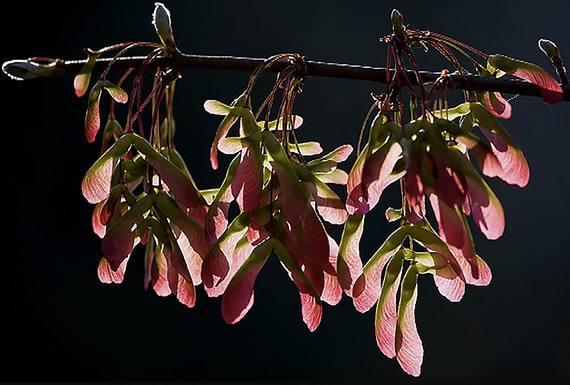
Watch for ways to use back lighting and side lighting.
Lighting can give an ordinary object life. The way light casts shadows on your subject or captures a certain feature can make an otherwise ordinary picture into something extraordinary.
Pay attention to how the light illuminates your subject or scene. You may need to reposition yourself or your subject to get the light and shadows you desire. Try shooting with a variety of back, side, and front lighting to obtain the look you imagine.
Use light to create a mood. The color of the light can impact the mood of the photograph.
Wait for the “quiet light.” If you do shoot during full sun, wait for a cloud to pass over the sun to diffuse the light. Tharp calls this “quiet light” and says it’s great for photographing people and capture details in an object.

Tharp waited for a cloud to pass so she could capture the detail of the letters engraved on this old tombstone–something she says would not show up in a photo if photographed in full sun.
Dynamic Compositions
“A strong composition is when the raw materials–light, shape, line, etc.–are arranged in a meaningful way, and so give impact to the photograph.”
Even if you have all the perfect elements to create an amazing picture, Tharp says you must compose them in a way that conveys a specific meaning. The three main points you need to consider when dynamically composing a piece include:
- Subject Position and Balance
- Proportion and Scale
- Counterpoint
Subject Position. Tharp suggests starting with the infamous rule of thirds–a technique that draws imaginary lines through your viewfinder, breaking your image into thirds both horizontally and vertically. This results in four intersecting places where you can place your subject to make your composition more dynamic. To figure out which of the points to use, decide what story you want your image to convey and consider people in this country most often read (and view photos) from left to right.
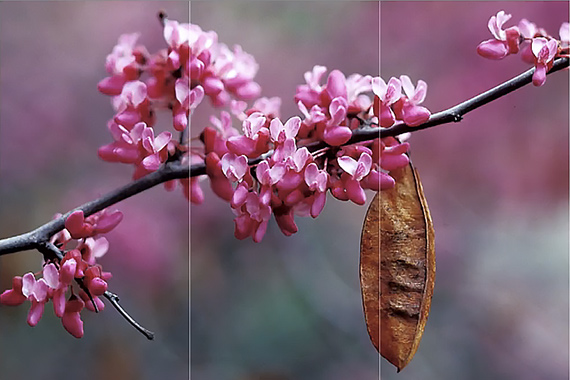
Tharp wanted to convey the story of “old and new,” so she wanted the viewer’s eye to travel left to right along the branch, out to the seed pod, then follow the pod down the right third of the photograph.
Here are a few other tips to compose more interesting pictures:
- Compose in a way that feels comfortable. Don’t force the subject to be in a location that feels awkward or unnatural.
- Consider negative and positive space. More negative space will force the focus onto your subject, while filling the space with your subject often gives a more intimate feel. The story you’re trying to tell will help you determine how much negative space you should use.
- Allow space for moving objects to “move.” If you photograph a running horse, allow more space in front of the horse for it to run. This helps portray the action and looks much more natural than a photo that captures the horse running out of the frame.
- Get one axis off center. If you are photographing a subject that could be completely symmetrical (a reflection, a face, flowers, etc.) you need to make sure that one axis is off center. The reason being that as humans, we like to look at something that is asymmetrical rather than something symmetrical.
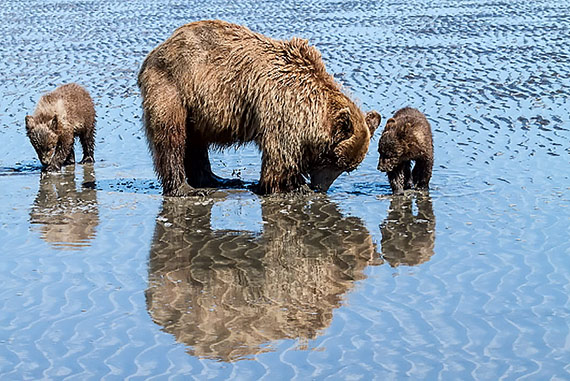
Tharp framed the image to move the horizontal line of reflection above the midline of the photo to make a potentially symmetrical image asymmetrical.
Proportion and Scale. In a photo with several potential subjects, you should draw the viewer’s eye to the intended subject by making it larger. Tharp says this can be done through the use of perspective, by putting your subject closer to the camera.
Counterpoint. Sometimes you need additional information in the scene to convey the full context. By adding small counterpoints to your photograph, you can better tell a story without drawing the focus away from the subject.
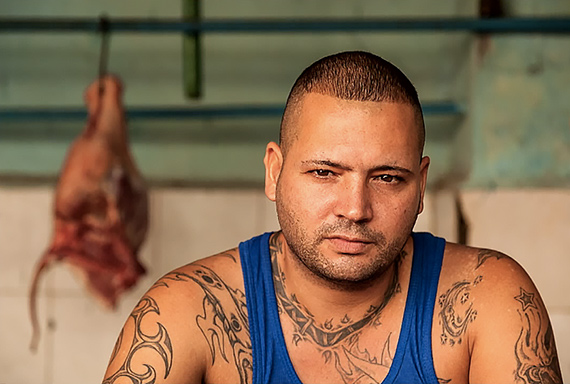
Without the hanging meat in the background, the viewer would never know this man is a butcher.
Angles. “Setting up a tripod at shoulder height is static,” says Tharp. To create a more dynamic image, you need to change the angle from which you shoot. Most commonly, this means you either need to get down on the ground and shoot upward, or find a way to elevate yourself (or at least your camera) to aim downward and capture the image using an elevated approach.
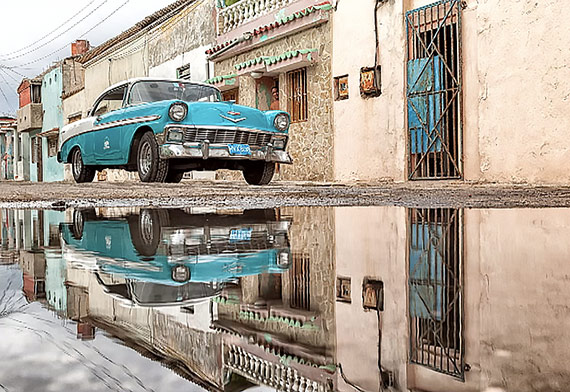
Tharp got down on the ground to capture this low angle of this car and its reflection to produce a more dynamic photograph from an otherwise stagnant, static situation.
Leading the Eye. As a photographer, you are a storyteller. Therefore, you need to create a complete story within the confines of a single image. Ideally, you want to compose your picture so you lead the viewer’s eye through the entire photograph, telling the story along the way.
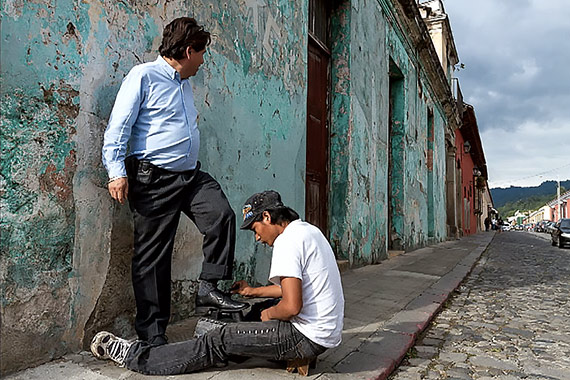
Tharp admits to missing the moment between the two men because just before she took this shot, the man getting his shoes shined was looking down at the man shining them, so you could see more of a moment between the two. Instead, she captured the man looking down the street, so the viewer’s eye naturally follows his glance, looking down the street to where nothing is going on.
“Where humans are looking, you tend to look as well.” Tharp says this is also true for animals in photographs because wherever the subjects glance is going, the viewer will naturally follow their line of sight to another point in the picture.
Elements of Design
Several design elements can be used in photography to make an otherwise ordinary photo into something special. Such elements include:
- Lines
- Shape
- Pattern
- Texture
Lines. Repetitive lines in a photograph make an image more interesting. Lines can be created through shadows (light coming through blinds), or natural (water falling over the edge of a rock ledge).
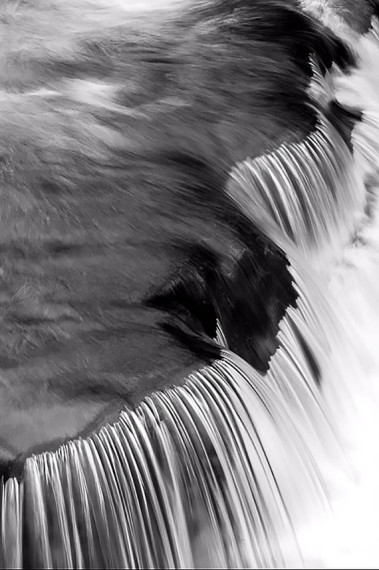
Tharp combines the scalloped edge lines of the rock with the repetitive lines in the water as it flows over the edge.
Shape. Since photography is a two-dimensional medium, every object is viewed as a shape. Combining contrasting shapes in a single image allows for an interesting juxtaposition that can create a more dynamic photo.
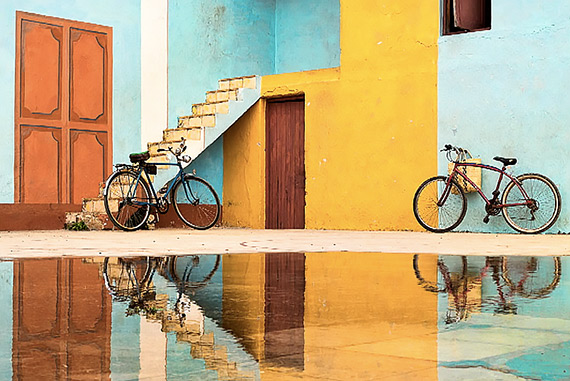
Tharp shot this photo because it was chalk full of a variety of shapes in an interesting combination. The circles of the bike tires, the rectangular doors, and the sharp edges of the stairs are all emphasized by the reflection.
Pattern. Repeated patterns can be soothing, invigorating, or add interest to an otherwise static photo. Tharp says a key to capturing a pattern in a picture is to fill your frame so the pattern spills out the edges of your viewfinder to emphasize the ongoing nature of the pattern.

Tharp thought the image of the fish in the baskets would make an interesting picture as a single subject, but found the repeated pattern resulting from showing all the baskets created a much more dynamic photograph.
Texture. Crisp, sharp images of subjects with specific textures add an interesting and dynamic element to your photograph. Tharp suggests focusing on something with a texture that makes you want to reach out and touch it.
Creating Visual Depth
Ultimately, photography distills a 3D world into 2D. “Despite it being a flat photograph, we need to create an illusion of depth,” says Tharp. To do this, you need to use depth of field, perspective, and selective focus. Tharp reminds us that all these aspects will shift based on how and where you, as the photographer, move when taking the photo.
Near/Far Relationship. Often used in landscape, this relationship is all about perspective.
Selective Focus. This technique is used to make a single element stand out due to its sharpness compared to everything else in the picture. Tharp explains that “other elements may tell you the story of the picture, but only one single item is deemed ‘important’ using this technique.”
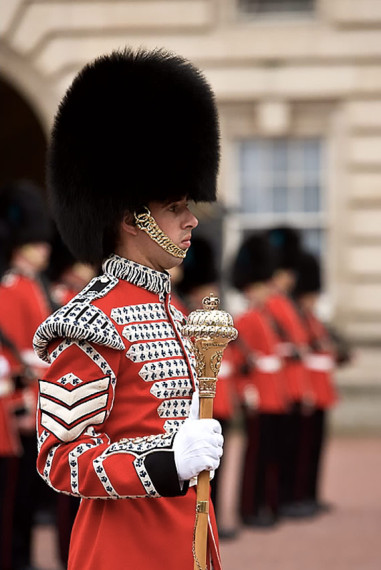
Tharp tells us that the focus is on the single guard. She visually tells us this by ensuring he won’t blend in with the rest of the guards, keeping his uniform and facial expression in focus.
Gesture. The moment when there’s an expression in the body language or face of the subject is referred to as “gesture.” Often seen with animals and small children, gesture can be captured with nearly any subject in non-posed situations. One piece of advice Tharp shares is that “you must be ready to capture these moments because they are fleeting.” She goes on to say “if you are going to take a little while to photograph people, talk to them. This keeps them engaged. Otherwise, they will start to feel uncomfortable and their expression and body may freeze, resulting in an uncomfortable, unnatural photo.”

Tharp shares one of her photos capturing the gesture of a wave in nature.
Expressive Techniques
You can use a combination of the techniques listed to convey a certain mood or expression in your photographs.
“I asked, ‘what if I slow the shutter speed down?’ to capture the energy and frenzy of the market. Some people are frozen in time, others are moving to abstract the moment.”
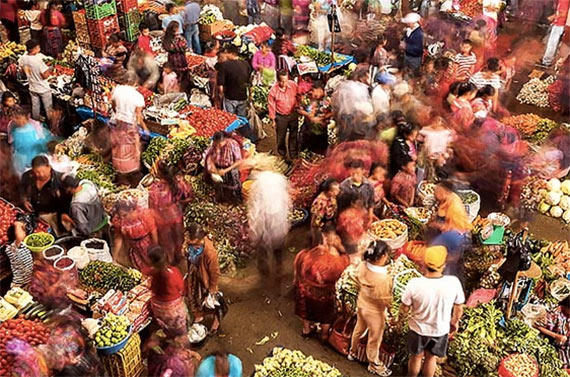
Tharp used a slower shutter speed to capture the chaotic scene in a shopping market.
Ultimately, you want to create photographs that convey your own personality, tone, humor, and vision.
“Open up to seeing without question and taking in the wonderful, beautiful things that are around us. Take these things in and add to it the mastery of your craft to create amazing, dynamic images.” –Brenda Tharp
Like This Article?
Don't Miss The Next One!
Join over 100,000 photographers of all experience levels who receive our free photography tips and articles to stay current:






Hi Sari
This is the best technique I read so far I keep in my mind and I try to remind that technique all the time when I take a picture.